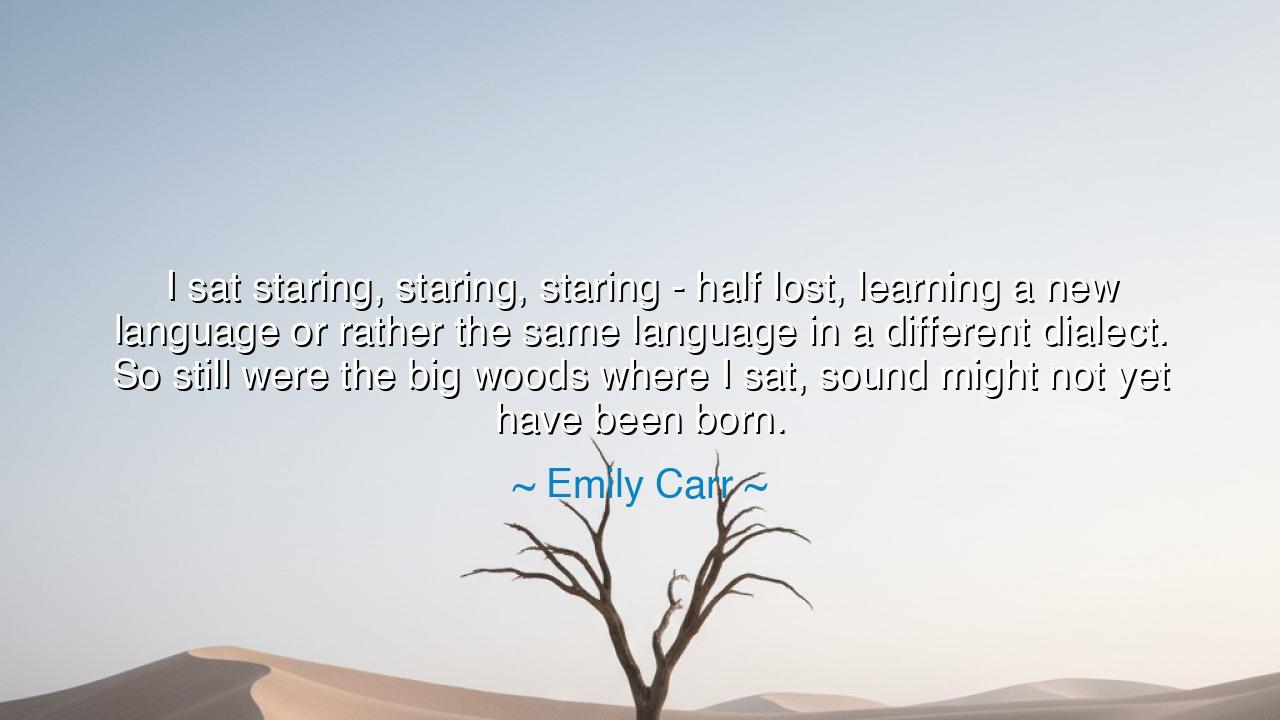
I sat staring, staring, staring - half lost, learning a new
I sat staring, staring, staring - half lost, learning a new language or rather the same language in a different dialect. So still were the big woods where I sat, sound might not yet have been born.






“I sat staring, staring, staring — half lost, learning a new language or rather the same language in a different dialect. So still were the big woods where I sat, sound might not yet have been born,” wrote Emily Carr, the visionary artist and seeker of nature’s soul. Her words, carved from silence and solitude, are not merely the reflections of a painter, but the revelations of a mystic who had come face to face with the living spirit of creation. In this brief, haunting passage, Carr unveils a truth as old as the mountains: that there are languages deeper than words — the speech of wind and leaf, of moss and shadow, of stillness itself. To hear it, one must first become still enough to listen.
In the still woods of British Columbia, Carr found herself standing between worlds — the world of human noise and the vast, breathing consciousness of the forest. Her staring was not mere observation, but communion. She was learning the dialect of trees, the syntax of silence, the rhythm of the earth’s slow heartbeat. The new language she speaks of is the language of presence — one that cannot be written, only felt. To learn it, she had to unlearn the chatter of civilization, to quiet the mind until even her own thoughts became whispers. In that silence, she discovered that sound might not yet have been born — that creation itself speaks through stillness before it speaks through form.
This revelation was not unique to her, though few have spoken it so tenderly. The ancient sages of many lands, too, sought to learn from the silence of nature. In India, the rishis retreated into forests to hear the voice of the divine in the rustle of leaves. In China, poets like Li Bai wandered among rivers and mountains, finding enlightenment in reflection and mist. And in the West, St. Francis of Assisi called the birds his brothers and the sun his kin. Emily Carr, though of a different time and tongue, joined their company — a soul who understood that the earth itself is a scripture, written not in ink but in stillness.
Her words also speak to the artist’s eternal struggle: to translate what cannot be spoken. Carr’s art was not just paint upon canvas; it was an act of translation — of turning the sacred language of nature into human form. When she writes of learning “the same language in a different dialect,” she reveals the humility of one who knows that human expression can only echo, never fully capture, the mysteries it beholds. Each brushstroke, each color, was her attempt to speak the dialect of the forest, to give voice to its silence. The woods, for her, were not background but being — ancient, watchful, and alive.
There is a lesson here, both gentle and profound: to truly learn, one must surrender. To understand the world, one must first forget oneself. The mind that rushes, calculates, or seeks to dominate cannot hear the music of stillness. But the soul that sits quietly — staring, staring, staring — will begin to perceive what the ancients called the harmony of the spheres. In that state of quiet attention, one learns that nature does not speak to us; it speaks through us. Its language becomes our own, if only we allow it.
Consider, for a moment, the story of Henry David Thoreau, who went to the woods of Walden Pond seeking truth. Like Carr, he sat among the trees and learned to listen. There, he realized that the forest was a mirror — that every sound, every silence, revealed something about the self. He discovered, as she did, that the language of nature is the language of the soul. Those who learn it return to the world changed, speaking with a clarity that no formal tongue can match.
Therefore, O seeker of wisdom, remember this: the greatest teachers do not always speak. Sometimes they stand tall in the quiet — like trees, like mountains, like the infinite sky. If you wish to learn the new language, go to the still places of the world. Sit where no noise reaches you. Listen not with your ears, but with your spirit. Watch the dance of light through the branches. Feel the pulse beneath the soil. There, you will find what Emily Carr found: that the universe is speaking — softly, eternally — and that you, too, are part of its speech.
So let her words be your guide: stare, stare, stare until your vision deepens into understanding. Be half lost, for in that loss, you will be found. In silence, learn to hear. In stillness, learn to see. And when you return to the noise of the world, carry with you the calm language of the woods, for that is the tongue of truth, and it will speak peace to every restless heart.






AAdministratorAdministrator
Welcome, honored guests. Please leave a comment, we will respond soon